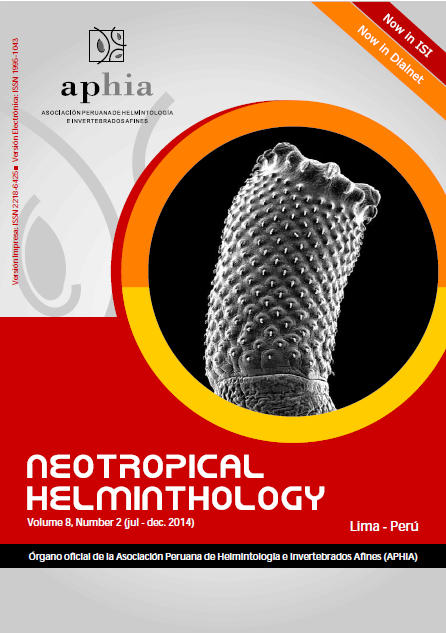BIODIVERSITY OF ENTOMONEMATODES PARASITIZING SOIL PEST WHITE GRUBS (SCARABAEIDAE) OF BUENOS AIRES, ARGENTINA
DOI:
https://doi.org/10.24039/rnh201482915Keywords:
Argentina, biodiversity, nematodes, parasites, plagues.Abstract
This work was carried out between 2006-2010 in wheat fields of the Pampas, Argentina, in order to examine the species of nematode parasites and pathogens of white grubs, soil major pest. Samples were taken with shovel in randomly selected sites. Nymphs of Diloboderus abderus and Cyclocephalla signaticollis (Scarabaeidae) were collected. Thirteen species of nematodes belonging to 5 families (Mermithidae, Thelastomatidae, Travassosinematidae, Diplogasteridae and Rhabditidae) were identified. The richness of species values were 1 for Cyclocephalla signaticollis and 12 for Diloboderus abderus. The thelastomatids and rhabdítids were the largest group of nematodes, with a total of 3 species each. The thelastomatids were very prevalent with infections exceeding 60%, followed by diplogasterids which reached 36%. The mermithids were less prevalent with values close to 10%. The family Travassosinematidae had the lowest abundance (0.32). Knowledge of nematode community will be a great value to interpret hostparasite relationships and in many cases determine those species best potential bioregulators important agents in agricultural areas of Argentina. This study is the first in the Pampas region of Argentina to provide a list of white worms parasitic nematodes.
Downloads
Published
How to Cite
Issue
Section
License
Copyright (c) 2021 Neotropical Helminthology

This work is licensed under a Creative Commons Attribution-NonCommercial-NoDerivatives 4.0 International License.
OBJETO: El AUTOR-CEDENTE transfiere de manera TOTAL Y SIN LIMITACIÓN alguna al CESIONARIO los derechos patrimoniales que le corresponden sobre la (s) obra(s) tituladas: xxxxxxxxxxxxxxxx, por el tiempo que establezca la ley internacional. En virtud de lo anterior, se entiende que el CESIONARIO adquiere el derecho de reproducción en todas sus modalidades, incluso para inclusión audiovisual; el derecho de transformación o adaptación, comunicación pública, traducción, distribución y, en general, cualquier tipo de explotación que de las obras se pueda realizar por cualquier medio conocido o por conocer en el territorio nacional o internacional.
REMUNERACIÓN: La cesión de los derechos patrimoniales de autor que mediante este contrato se hace será a título gratuito.
CONDICIONES Y LEGITIMIDAD DE LOS DERECHOS: El AUTOR-CEDENTE garantiza que es propietario integral de los derechos de explotación de la(s) obra(s) y en consecuencia garantiza que puede contratar y transferir los derechos aquí cedidos sin ningún tipo de limitación por no tener ningún tipo de gravamen, limitación o disposición. En todo caso, responderá por cualquier reclamo que en materia de derecho de autor se pueda presentar, exonerando de cualquier responsabilidad al CESIONARIO.
LICENCIA DE ACCESO ABIERTO: El AUTOR-CEDENTE autoriza que manuscrito publicado en La Revista Neotropical Helminthology permanece disponible para su consulta pública en el sitio web https://www.neotropicalhelminthology.com/ y en los diferentes sistemas de indexación y bases de datos en las que la revista tiene visibilidad, bajo la licencia Creative Commons, en la modalidad Reconocimiento-No comercial- Sin Trabajos derivados –aprobada en Perú, y por lo tanto son de acceso abierto. De ahí que los autores dan, sin derecho a retribución económica, a la Asociación Peruana de Helmintología e Invertebrados Afines (APHIA), los derechos de autor para la edición y reproducción a través de diferentes medios de difusión.


 Numero 2 Volumen 19 - 2025 (versión Anticipada)
Numero 2 Volumen 19 - 2025 (versión Anticipada)














































